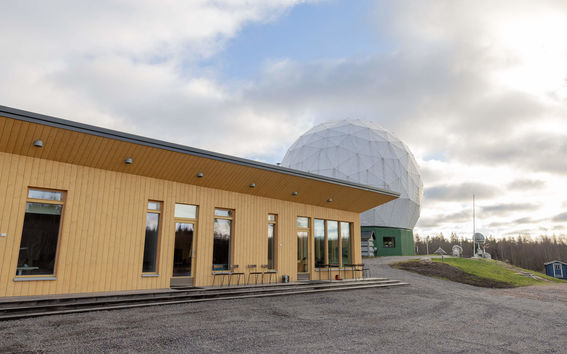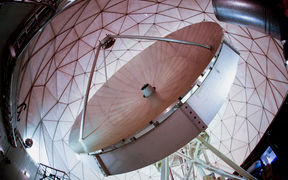A radio telescope follows the partial solar eclipse even through clouds

On Tuesday October 25, a partial solar eclipse will be observed in Finland and at Aalto University's Metsähovi Radio Observatory in Kirkkonummi. The solar eclipse will be visible from 12:11 to 14:31 and is at its deepest at 13:21, when the Sun will be 62.7 percent covered. The exact times of the solar eclipse have been calculated for Kirkkonummi and western Uusimaa.
Finland's only astronomical radio observatory is located at Metsähovi. Even if the weather would be cloudy at the time of the partial solar eclipse, Metsähovi's radio telescope will be able to take photos and prepare solar maps, as well as record the eclipse even through clouds, as long as the cloud layer is sufficiently even.
At Metsähovi, the event will also be observed by Jay M. Pasachoff, Chair of the International Astronomical Union’s Working Group on Eclipses. Professor Pasachoff, who is visiting Finland for the second time, is looking forward to seeing a solar eclipse for the 37th time. On his first visit to Finland in 1990, he and his family watched a total solar eclipse from an aeroplane. His archive covering dozens of solar eclipses is available at http://totalsolareclipse.org.
'Total solar eclipses and the sudden darkening of the sky are perhaps the most dramatic things any human can see. Every person watching the eclipse should acquire special eclipse filters for eye safety,' he says.
'Solar eclipses occur so rarely that even though they are not at the core of our scientific research, we want to observe all eclipses from start to finish. In general, in connection with a solar eclipse, the properties of the Sun's surface and its parts can be studied,' Metsähovi Director Joni Tammi says.
Professor Pasachoff's long career and knowledge of monitoring solar eclipses are also known at Metsähovi, and his visit will deepen Metsähovi's international cooperation in solar research.
The benefits gained by astronomy from solar eclipses are due to the influence of the Moon. If there are areas that are active in the Sun during a eclipse, radio brightenings, their details, or structures, will be studied closely at Metsähovi.
Because we know exactly the speed at which the Moon and the Sun move across the sky before and after an eclipse, Professor Pasachoff says that we are able to combine the data collected by different measuring devices with extreme accuracy.
'We can achieve higher resolution by combining data from Metsähovi with extreme ultraviolet and X-ray spectrum views provided by satellites following an eclipse, such as NASA's Solar Dynamics Observatory and Japan's Hinode.'
Solar eclipse observations help to further the research on and development of equipment
At Metsähovi, the Sun is observed on a daily basis, but the focus of solar research is on monitoring the long-term variability of the Sun and research on individual solar flares.
Solar eclipse observations are important for evaluating research on equipment, development and performance.
'Getting the Moon and the Sun in the same image helps in determining and calibrating the accuracy of equipment. During a solar eclipse, we can also assess the size and shape of the areas visible on the surface of the Sun with radio frequencies more accurately than is normally the case, as the edge of the moon acts as a kind of focusing mechanism,' Tammi says.
This phenomenon can be described as being similar to a strongly myopic person looking at a distant light source. This person cannot accurately make out the size of a distant lamp as it looks blurred, but if an assistant walks past the light at a known speed, it is possible to calculate the size and shape of the object quite accurately using the dimming and brightening of the light as a clue.
Laboratory Engineer Juha Kallunki says that everyone has the opportunity to observe the course and progress of a solar eclipse in real time by following the precision maps of the Sun's millimetre range produced at Metsähovi.
'We also monitor data from smaller solar telescopes to see how the total flux of solar radio radiation changes as the eclipse progresses, as well as environmental parameters, such as changes in the outside temperature.’
The data collected during the day and the related links will be updated online in almost real time at http://www.metsahovi.fi/sun/eclipse_2022/ (in Finnish).
Data on solar eclipses will also be included in Metsähovi's open solar data set, which anyone can use afterwards as they wish.
Professor Pasachoff's online lecture on eclipses on 25 October from 18:00.on can be viewed on Ursa's YouTube channel.
Further information:
Joni Tammi, Director of Metsähovi
[email protected]
phone 029 442 4858
Jay M. Pasachoff
Professor
Chair (International Astronomical Union’s Working Group on Solar Eclipses)
Email: [email protected]
Juha Kallunki, Laboratory Engineer
[email protected]
phone 029 442 4852
Metsähovi Radio Observatory
Metsähovi Radio Observatory is the only astronomical radio observatory in Finland. Metsähovi’s main instrument is the 14-metre radio telescope, which is used around the clock, every day of the year. Its observational data is used, e.g., for studying active galaxies, the Sun, and the rotation of the Earth.

Read more news

DeployAI Partners Gather for Heart Beat Meeting in Helsinki
The European DeployAI project's partners gathered for the Heart Beat meeting hosted by Aalto University Executive Education in Helsinki.
Get to know us: Associate Professor Maria Sammalkorpi
Sammalkorpi received her doctorate from Helsinki University of Technology 2004. After her defence, she has worked as a researcher at the Universities of Princeton, Yale and Aalto.
Aalto computer scientists in ICML 2024
Computer scientists in ICML 2024